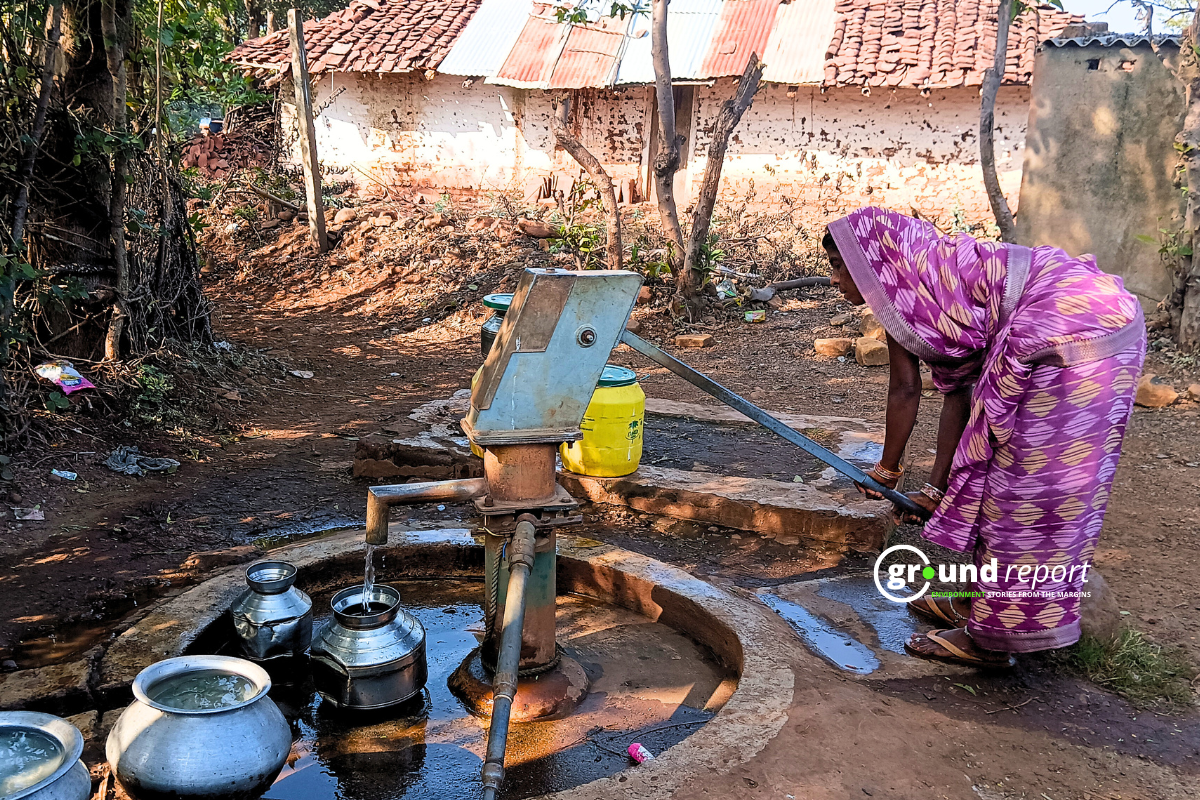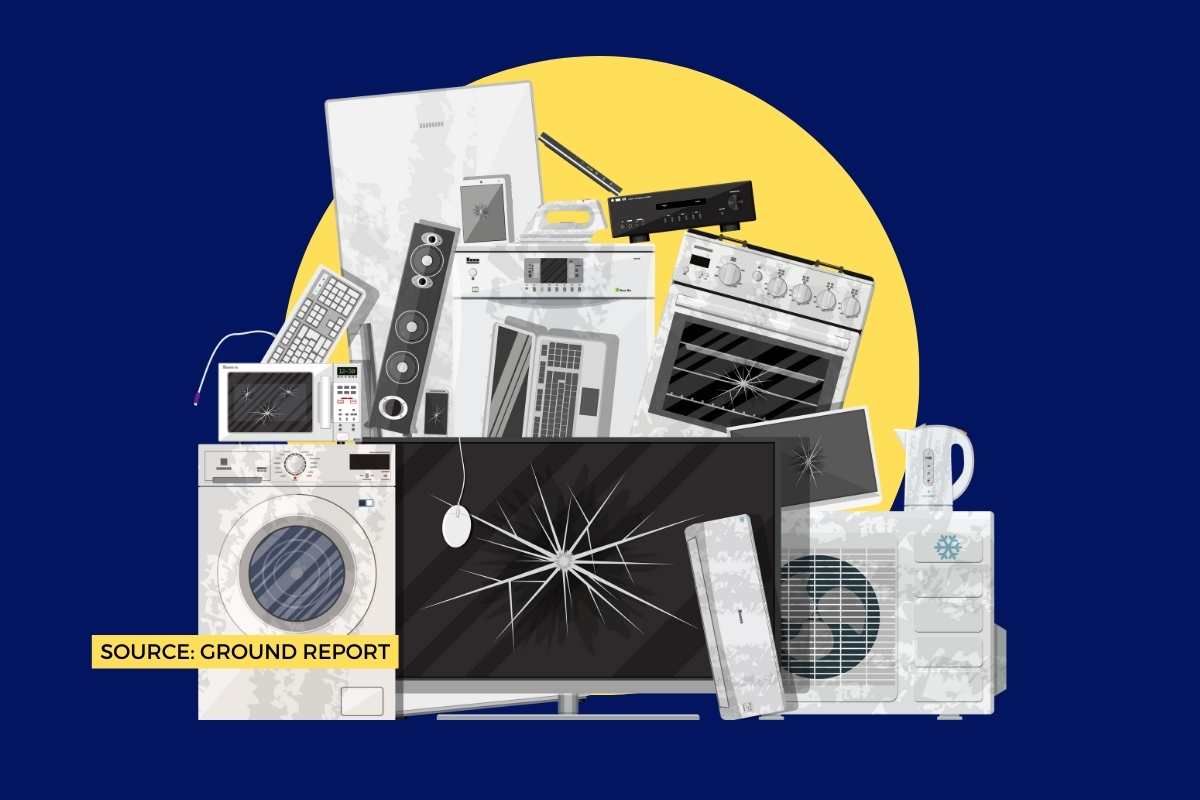Read in Hindi| Bundelkhand’s remote villages’ on-ground realities contradict the information available on the Jal Jeevan Mission dashboard. A school teacher in Hanuman Sagar village of Bundelkhand region while preparing for voting day on 26th April, said the school has had no water since its inception around 1975. However, the Jal Jeevan Mission dashboard indicates functional tap connectivity in the schools. But, when we visited the tanks remained dry and the taps were broken.
Jal Jeevan Mission (JJM), envisioned to provide safe and adequate drinking water through individual household tap connections by 2024 to all households in rural India, is considered one of the celebrated works of the ruling BJP government. To maintain the transparency of the work done under the Har Ghar Jal Scheme–under the Jal Jeevan Mission– people rely on the JJM dashboard for updates.

Hanumansagar is a village in Bori gram panchayat of Tikamgarh district in Madhya Pradesh. The village has a population of 1243 of which 662 are males while 581 are females as per Population Census 2011. The village is six km away from Tikamgarh town, with no direct public commute or even a primary healthcare centre. People generally travel to the town for treatment and other economic activities.
The village’s primary school, with only three classrooms, is till 8th standard and has 200 students. As the village goes to vote on 26th April in phase two polling for general elections, the residents look for a better future with easier accessibility to public transport, healthcare, education and water.
Why are school washrooms locked?
“I have a daughter in 4th standard, she runs back home if she has to use the washroom. The washroom in school is shut with no water,” said Mamta, a resident of Hanumansagar village in the Bundelkhand region of Madhya Pradesh.
Despite having a pond nearby, the primary school still lacks any water connectivity, hence the toilets, though constructed, remain shut.

“Children also come back home in the middle of their classes to drink water and don’t go back, it severely impacts their studies,” Mamta added.

Tikamgarh district is one of the thirteen districts of the Bundelkhand region in central India. The region known for its droughts suffers every summer from water-crisis. A declining rainfall trend between 1901 and 2013, varying from 0.49 to 2.16 mm per year in the Bundelkhand region was observed according to a study, published in Current Science in 2019.
“They have tried digging a borewell thrice but failed” informed the teacher.
According to a research paper, there is insufficient groundwater recharge in the Bundelkhand region due to speedy runoff of surface water and low intensity of the short rain spell. High evaporation of the surface water due to bare plateau-areas. Most of the Bundelkhand region comprises hard rocks that are inappropriate for harnessing groundwater potential.
During our visit to the village, we observed at least three hand pumps, including one on the school premises, were non-functional. Teachers carry their water bottles and drink accordingly to avoid the chances of going to a washroom.
“We used to take ‘help’ from children to fetch water to fill containers in school, but after the parents objected, we now carry it ourselves as there is no peon in the school,” added another teacher.
Another village, same story
Ram Chandra Yadav, 50, a headmaster in a primary government school in Bauri village in the same district was disheartened at the condition of the school and low student turnout in summer.
“This happens every year, due to this hot weather students stay at home. We have 121 students here, but only 10-15 are coming to school these days,” Yadav informed.
Yadav took us to look at the toilets constructed last year in the school premises but remained locked with no water facility, let alone a hand washing facility.
In Bauri village of the same gram panchayat in Tikamgarh, the situation is worse. The people receive water for only half an hour under Har Ghar Jal Yojna in a day. But, there is no trace of water connection in primary school. According to the JJM dashboard, both primary and middle schools of the village have functional tap connectivity and hand washing facilities. However, when we visited the village, though the middle school had water connectivity, the condition of the primary school was concerning.

The village has a population of 1046 of which 548 are males while 498 are females as per Population Census 2011.

Burden on women
Not just schools, despite Har Ghar Jal Yojna, the implementation failure still forces women to walk up to 1 km to fetch water from a pond, when the hand pumps dry down.
“We have to fill up to 10 containers (dabbas) in a day from this handpump in hot summers and even this will dry up in a month or two,” informed Diksha Yadav, a resident of the village, to Ground Report.
As a whole across India, women spend an estimated 150 million work days every year fetching and carrying water, equivalent to a national loss of income of Rs 10 billion or $160 million.
Worse Summers, But no Water
According to Yadav, he has filed several complaints with the Public Health Engineering (PHE) department under the government of Madhya Pradesh. The department is responsible for rural water supply, but they have declined to take responsibilities after the pipelines were laid in June 2023 under Har Ghar Jal Yojna. The pipelines were later stolen.
The Indian Meteorological Department (IMD) this month has already forecasted extreme heat and more heatwave days in many states, including Madhya Pradesh.
As per United Nations Institute for Training and Research’s (UNITAR) climate modeling experiments, temperatures will likely be higher by about 2 to 3.5°C by the end of this century in Bundelkhand.
Not just scorching summers, India is home to 63.4 million rural people without access to clean water, the highest in the world. Rural populations in poor and geographically isolated areas like Bundelkhand face particular challenges in terms of accessing clean water. Water-borne diseases are a great concern in India, primarily spreading through polluted drinking water. As per an estimate, around 37.7 million Indians are affected by waterborne diseases annually, as per BMC public health journal.
BJP National President J P Nadda laid importance of the controversial Ken-Betwa river linking project to solve the water crisis of Tikamgarh during his visit to the district on 23rd April. But clearly, the Bundelkhand region including Tikamgarh district needs a sustainable water plan to meet the needs of the area.
“Climate change is real [in Bundelkhand region], but another thing that is real in this region is lack of awareness and accountability,” Yadav added.
The ground report has approached the PHE department for a comment. The story will be updated when we receive a response.
Keep Reading
Indian agriculture household earns just Rs. 10,218 in a month: Govt
Post-harvest losses still high, reveals data shared in Lok Sabha
Khadi Haat village’s power-free wastewater treatment solution and more
Support us to keep independent environmental journalism alive in India.
Follow Ground Report on X, Instagram and Facebook for environmental and underreported stories from the margins. Give us feedback on our email id greport2018@gmail.com.
Don’t forget to Subscribe to our weekly newsletter, Join our community on WhatsApp, and Follow our YouTube Channel for video stories.







